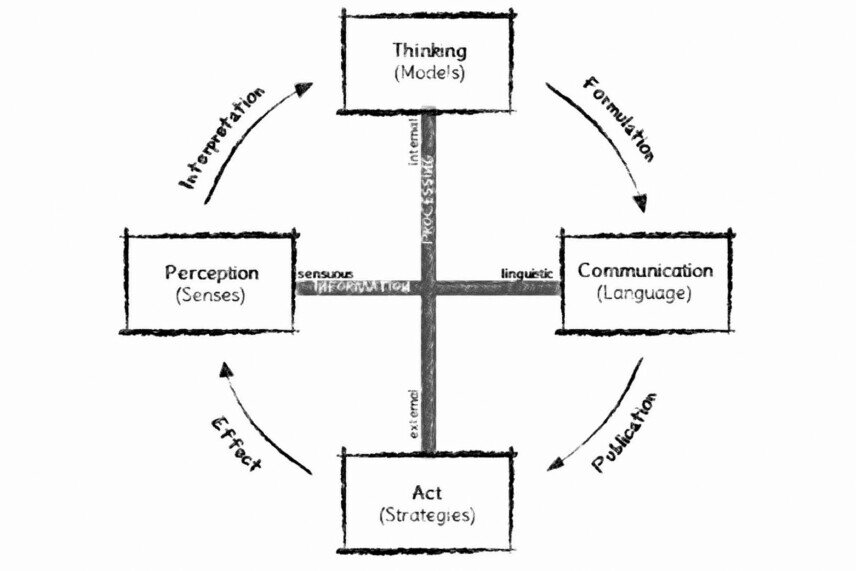Consciousness cycle
The consciousness cycle describes the dealing with the world and brings four areas together that cover the two axles information and processing level. Information is the interface to the environment and goes from sensuous perception to ‚linguistic’ communication. Perception notices the world with the five senses - just 10% consciously. Communication takes place via words, pictures, music, gestures, body attitude, and smell or gourmet creations. Processing describes the form of the exchange with the environment and reaches from internal thinking to external acting. Thinking handles the sensed stimuli received by perception, connects them with existing mental models, and generates new thoughts. Contents of communication are emphasized by behavior and actions. The result is a holistic, visual, auditory, kinesthetic, olfactory, and gustatory exchange with the world. The use of the consciousness cycle with its multi-sensuous influences, emotional and rational thought processes, as well as behaviors and actions, facilitates the determination, designing, and exchange of meaning.
The consciousness cycle consists of four areas: perception, thinking, communication, and act.

- Perception
is done with the five senses: seeing (visual), hearing (auditory), feeling (kinesthetic), smelling (olfactory), and tasting (gustatory). Of the 100% stimuli that are perceived by our senses, we use only 10% consciously. However, this does not mean that the remaining 90% are lost. On the contrary, the sensory stimuli influence our thinking that, by consciously considering our emotions, provides additional information.
- Thinking
processes stimuli coming from the outside and links them with already existing thoughts. Thus, individual, mental models arise that grow continuously and consist of ideas, topics, concepts, and models. Part of the results of thinking we recognize and refine. The bigger part consists of unconscious effects that work uncontrolled and affect our intuition, i.e., the gut feeling. More effective use of thinking requires new approaches. Tools are thinking models that help arrange thoughts, e.g., structured explanation, solution, and system models. These results improve later communication.
- Communication
covers all aspects that belong to the exchange of thoughts. The target group-oriented formulation amplifies the intended meaning and is more clearly expressed. It should not be forgotten that apart from the word, other communication channels exist. According to the motto ‚A picture says more than a thousand words’, all sense channels have ways to express something. Besides wording and visualization, i.e., the textual and visual realization of a message, sensuous documentation becomes more important. An example is the organization of smells in automobiles or books. The conscious organization of communication improves thought exchange and increases the effect.
- Act
contains all activities that usually go along communication, follows afterward, and becomes visible to everybody. This includes behavior, activities, and subsequent measures. Communication can, with the power of actual doing, be confirmed or questioned. Actions that do not fit the original intention are devastating. ‚One cannot not communicate’ meant for doing that every activity ALWAYS implies messages. To steer these acts, consciously improves the effect. This concludes the consciousness cycle and starts it again.
Any interaction with the environment follows this cycle. It is beneficial to go through each area consciously.

